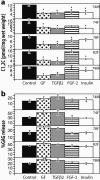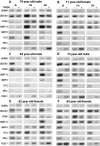Transforming growth factor-beta2 suppresses collagen cleavage in cultured human osteoarthritic cartilage, reduces expression of genes associated with chondrocyte hypertrophy and degradation, and increases prostaglandin E(2) production
- PMID: 16400016
- PMCID: PMC1592655
- DOI: 10.2353/ajpath.2006.050369
Transforming growth factor-beta2 suppresses collagen cleavage in cultured human osteoarthritic cartilage, reduces expression of genes associated with chondrocyte hypertrophy and degradation, and increases prostaglandin E(2) production
Abstract
Articular cartilage degeneration in osteoarthritis (OA) involves type II collagen degradation and chondrocyte differentiation (hypertrophy). Because these changes resemble growth plate remodeling, we hypothesized that collagen degradation may be inhibitable by growth factors known to suppress growth plate hypertrophy, namely transforming growth factor (TGF)-beta2, fibroblast growth factor (FGF)-2, and insulin. Full-depth explants of human OA knee articular cartilage from arthroplasty were cultured with TGF-beta2, FGF-2, and insulin in combination (growth factors) or individually. In cultured explants from five OA patients, collagenase-mediated type II collagen cleavage was significantly down-regulated by combined growth factors as measured by enzyme-linked immunosorbent assay. Individually, FGF-2 and insulin failed to inhibit collagen cleavage in some OA explants whereas TGF-beta2 reduced collagen cleavage in these 5 explants and in 19 additional explants. Moreover, TGF-beta2 effectively suppressed cleavage at low concentrations. Together or individually these growth factors did not inhibit glycosaminoglycan (primarily aggrecan) degradation while TGF-beta2 occasionally did. Semiquantitative reverse transcriptase-polymerase chain reaction of articular cartilage from six OA patients revealed that TGF-beta2 suppressed expression of matrix metalloproteinase-13 and matrix metalloproteinase-9, early (PTHrP) and late (COL10A1) differentiation-related genes, and proinflammatory cytokines (interleukin-1beta, tumor necrosis factor-alpha). In contrast, TGF-beta2 up-regulated PGES-1 expression and prostaglandin E(2) release. These observations show that TGF-beta2 can suppress collagen resorption and chondrocyte differentiation in OA cartilage and that this may be mediated by prostaglandin E(2). Therefore TGF-beta2 could provide therapeutic control of type II collagen degeneration in OA.
Figures





References
-
- Dahlberg L, Billinghurst RC, Manner P, Nelson F, Webb G, Ionescu M, Reiner A, Tanzer M, Zukor D, Chen J, van Wart HE, Poole AR. Selective enhancement of collagenase-mediated cleavage of resident type II collagen in cultured osteoarthritic cartilage and arrest with a synthetic inhibitor that’s speres collagenase (matrix metalloproteinase). Arthritis Rheum. 2000;43:673–682. - PubMed
-
- Poole AR, Howell DS. Etiopathogenesis of osteoarthritis. RW Moskowitz, Howell DS, Altman RD, Buckwalter JA, Goldberg VM., editors. Philadelphia: WB Saunders Co.,; OsteoarthritisDiagnosis and Medical/Surgical Management. (ed 3) 2001:pp 29–47.
-
- Poole AR. Cartilage in health and disease. Koopman W, editor. Philadelphia: Lippincott, Williams, and Wilkins,; Arthritis and Allied ConditionsA Textbook of Rheumatology. (ed 15) 2005:pp 223–269.
-
- Kobayashi M, Squires GR, Mousa A, Tanzer M, Zukor DJ, Antoniou J, Feige U, Poole AR. Pole of interleukin-1 and tumor necrosis factor alpha in matrix degradation of human osteoarthritic cartilage. Arthritis Rheum. 2005;52:128–135. - PubMed
Publication types
MeSH terms
Substances
Grants and funding
LinkOut - more resources
Full Text Sources
Medical
Research Materials

